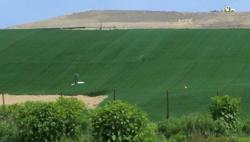With the ClosureTurf™ System, landfill operators are containing a greater amount of emissions and odors while simultaneously slashing costs and producing a superior gas for energy projects.
With the increased demand for better odor control as well as the need to capture the highest quality gas for green energy, landfill operators find themselves devoting more time and money to their sites’ Gas Collection and Control Systems (GCCS). Increasingly, national and regional operators are turning to a new product, ClosureTurf™, for a more streamlined and cost effective solution.

A side slope installation of ClosureTurf™ integrating existing vertical wells.
ClosureTurf™, distributed by Agru America, is composed of a UV-resistant, polyethylene grass laid over a 50-mil LLDPE structured drainage geomembrane. By integrating the final cap and the GCCS into one product, ClosureTurf™ has transformed the landfill closure process. With traditional closure methods, the GCCS, (composed of an elaborate array of pipes and vertical wells), and the final cap (composed of two feet of soil and grass), are installed separately. Both components are time and labor intensive, vulnerable to damage, and often the installation and maintenance of one requires damage to the other. In contrast, ClosureTurf™ employs the “surficial” method of gas collection, in many cases precluding the need for gas deep wells and piping. Emissions passively rise to the surface and are collected underneath an impermeable geomembrane where they are pulled by a minimal vacuum system for flaring or alternative energy generation. Designed to work as a standalone system or to enhance emission control for conventional wells, this seemingly simple design has increased the amount of gas collected while at the same time decreasing the time and capital invested. On average, the use of ClosureTurf™ can produce a per acre savings of $8,500 in GCCS cost and save as much as $45,000 per acre in post-closure maintenance (over a 30 year period).
Progressive Waste Solutions (formerly IESI-BFI Canada), one of the nation’s largest waste service providers, has discovered the economic and safety benefits of ClosureTurf™. Mike Friesen, a regional engineer for the company, has monitored its use on several of their sites and has walked away impressed. “As a final cap, the turf is exceptional. Our landfill gas system costs have been reduced 85% and post-closure costs have been reduced as well.” The LLDPE structured geomembrane contains emissions and, with no vertical wells serving as a pathway for oxygen, there is no possibility of fire outbreaks deep within the wells. Most importantly, with ClosureTurf™ it is economically feasible to close as little as one acre at a time, immediately reducing odor and controlling emissions.
For Director of Operations Delaney Lewis, it has been exciting to see more and more sites embracing this new technology. “As a former landfill manager I regularly saw operators struggling with the GCCS process. Our goal was to create a system that not only eased the monitoring burden but also allowed the cap and GCCS to work in conjunction with one another – no more destroying one to install (or repair) the other. ClosureTurf™ is virtually maintenance free; you just turn on the vacuum and let it work.”
Lewis also notes the environmental benefits of the product. “With more and more landfills seeking to harvest landfill gas for energy generation, it has become increasingly important to maintain the quality of the methane produced. ClosureTurf’s™ impermeable barrier captures 100% of the emissions while creating very little condensate . The fact that ClosureTurf™ can help turn what was once a hazard into a commodity with economic and environmental benefits is very satisfying.”
For Friesen, this potential revenue is just one more entry on ClosureTurf’s™ long list of benefits. “The future revenue from carbon credits and energy projects – it’s the icing on top of the icing on top of the cake. . . . why wouldn’t you use it?”

